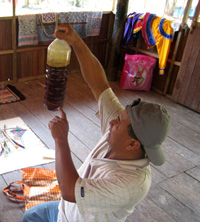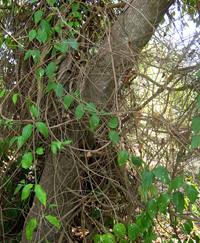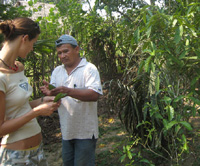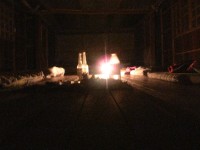AYAHUASCA
The word ayahuasca means “vine of spirits” or “vine of the souls”. The name itself suggests the ability of the substance to transfer a person into a different world, a “world of souls” subject to different rules than the world of everyday reality. A trained shaman can use that world pragmatically for his earthly purposes, however. At the beginning it is necessary to note that there is not just one “shaman school” or one way of performing the ritual. Every shaman is a unique practitioner who knows intimately the reality of widened perception; he is able to deal with it and solve possible difficulties of the participants in the ceremony. While some ayahuasqueros act as sensitive psychotherapists who keep their group in intimate contact with their own visions, others practice complicated rituals that require significant participation. This is common especially with curanderos, whose aim is solely to cure specific ailments.
The method of preparing ayahuasca is several thousand years old at least and not uninteresting as it consists of a completely improbable combination of two plants that usually occur in different locations in nature.
The first ingredient, leaves from the chacruna plant (Psychotria viridis), contains hallucinogenic DMT — the simplest of triptamine psychedelics, strikingly similar to the brain neurotransmitter serotonin. However, taken orally by itself, DMT has no effect. It remains completely inactive because it is immediately digested in the stomach by the so-called MAO (monoamine oxidase) enzymes. For some reason, the human body acts quite paradoxically: thanks to the omnipresent MAO enzymes, the body has effective mechanisms that prevent DMT from getting in the blood system. On the other hand, a group of Japanese scientists (see Strassman: DMT, The Spirit Molecule) discovered in 1985 that if DMT is already present in the blood system, the brain is literally “hungry” for it and transports the substance actively through its protective system in its tissue. No other psychedelic substance is known that the brain would accept so keenly and in a way treated it as if it was glucose, its basic source of energy.
Only the presence of the second ingredient, the ayahuasca liana (Banisteriopsis caapi) that gives the brew its name, inhibits the above-described MAO enzymes for several hours. Consequently, DMT can resist immediate metabolism in the stomach, get into the bloodstream and produce psychological effects. It is not known how ancient Indians discovered this combination. In old visions this combination is described as the ultimate love story, when the spiritual forces of both plants longed for each other and gave birth to one of the greatest gifts of the gods to men.
What is the experience with ayahuasca like? Similar for everyone and yet different. The altered state of consciousness is experienced differently by an adolescent student, a housewife, or a scientist. Each may go through the same process but experience it from very different levels of their knowledge and existence. Usually the experience seems like an intense encounter with the sacred, with divinity, a higher order of things not separate from us but of which we are (unknowingly) a part.
Life itself can be viewed on a basic level as an endless amount of conscious, interacting vibrations, as dynamic pulsating energy whose purpose is “to flow” and whose “fuel” is passion. The purest form of that passion is love, which stands behind all creation. Elementary emotions now seem to be the only “valuable currency” for everything living, as they provide flow and access to this primary creative energy. Just this encounter with emotive reality of the unconscious world, which is often experienced very visually, presents from a therapeutic point of view an unusually strong springboard for the release of various healing and purifying processes.
It is understandable that the above-mentioned description can seem somewhat naive to an uninitiated reader. However, only the practice itself can prove how difficult it is to transfer the experience in words. The above-mentioned dimension of interacting lucid energies (also often called “astral world” in the tradition of western magic), the place from which the shaman performs his actions, still represents a very particular sensation. At this point, the journey of the astonished mind which has won a ticket to the infinity only begins. Although the state of mind caused by ayahuasca can be compared to the effects of the better-known LSD, popularized in the 1960s thanks to the psychedelic movement around Timothy Leary, there exist two significant differences: Ayahuasca bears STRUCTURE and IDENTITY.
The first aspect is connected with the fact that, exept changes in consciousness after drinking the beverage, there is a physical sensation of drunkenness (that's why the Spanish name for the state under the influence of ayahuasca is called “mareacion”), but access to reason, intellect and the material world are not usually disrupted. “Other dimensions” just open up to the consciousness and it obtains the ability to travel on a mythological axis mundi and perceive being from many parallel realities that seem to exist independently. Consequently, the result is not a psychosis, which is so common for artificially synthesised LSD trips, but a very natural form of alternative perception, which is totally in context with everything live. Instead of chaos, the existense seems to be very clearly and precisely structured — although this knowledge is very difficult to abstract into rational-logical schemes, because paradox seems to be one of the cornerstones of the universe.
The described effects are closely connected with the second important aspect, the identity of the plant itself. Ayahusca together with several other psychedelic substances (e.g. the cactus peyote - Lophophora williamsii) used by the people of the fourth world are dubbed teaching plants (planta maestra). During the session, the plant substance of ayahuasca can be perceived as a strange, intelligent being, an independent, personal guide with very particular qualities that teaches one “how to live properly”. Meeting the guide presents one of the most bizarre, but at the same time one of the most charming, features of the ayahuasca ceremony. Its personality appears to be immense, powerful, wise, uncomplicated and friendly but firmly defending its interests, which are identical with the interests of life and all creation. The identity of ayahuasca is the life itself — strong, organizing and colonizing the wastelands of space. Accepting the existence of a higher independent intelligence able to confront us with our own life, as well as with aspects of all being, is an uneasy task for a western mind, but ultimately gives the experience an unusually strong and intimate dimension.
In other words, ayahuasca allows you to peer into the deepest corners of your soul or connect with the most remote planes of creation. You might feel as though you are in full control of your experience or quite the opposite, that you are relentlessly exposed to images, emotions and stories which the plant is “convinced” you should see. The nature of the experience can be as diverse as existence itself. If you approach it with trust and humbleness, it will definitely be a positive process, as the ego is suppressed and consciousness re-connected to the unity of the whole live being. On the other hand, this experience is not suitable for everyone. Ayahuasca mercilessly breaks down conventional ideas about the world and oneself. The experience is irreversible and certainly does not function as a pleasant recreational drug. For these reasons it makes sense to have a clear answer beforehand to the question WHY you want to remove the veil.




